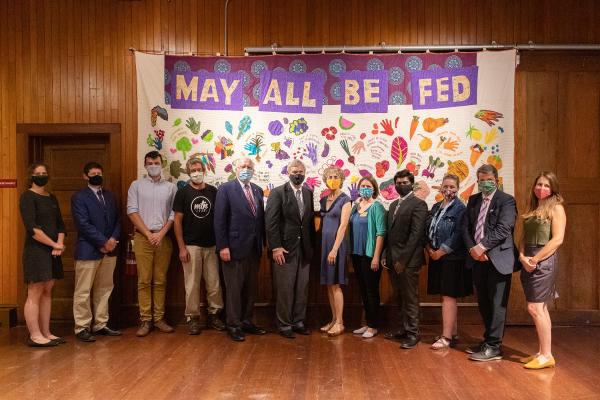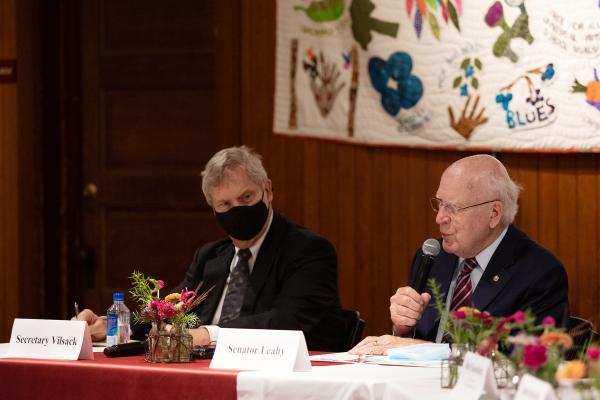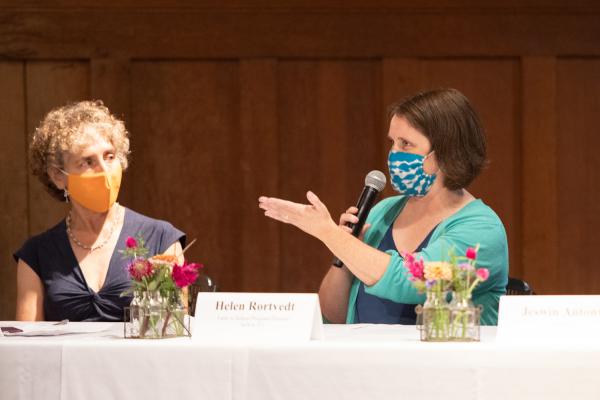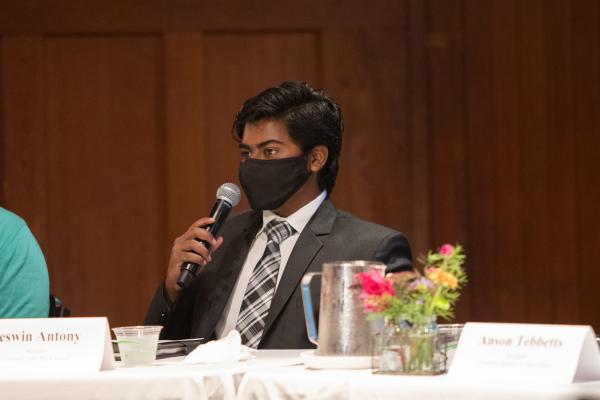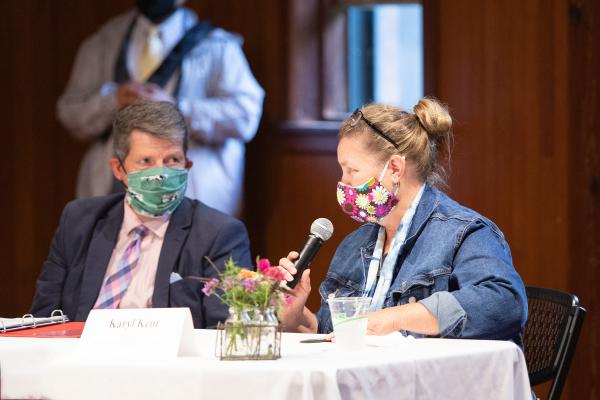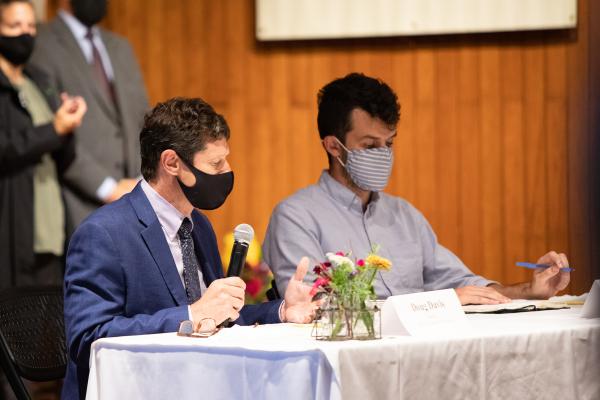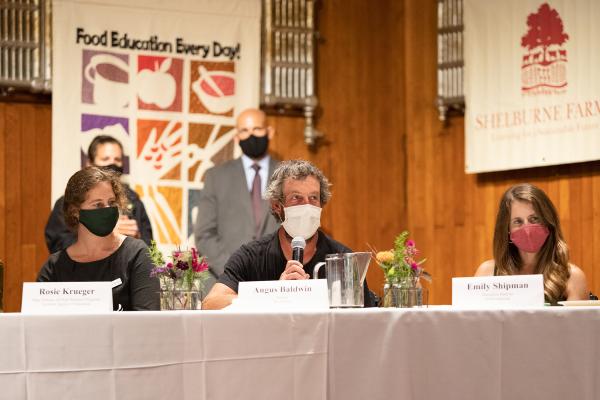Farm to School: Stories of Promise and Impact
On August 19, U.S. Senator Patrick Leahy and U.S. Secretary of Agriculture Tom Vilsack came to Shelburne Farms to announce their direct and continuing support for farm to school efforts, including Vermont FEED’s Northeast Farm to School Institute, a project of Shelburne Farms and NOFA-VT. It was only appropriate that their remarks were made at the Coach Barn, where the Institute’s kick-off gathering has long been held (it has been virtual the past two years).
Both Senator Leahy and Secretary Vilsack are long-time champions of Farm to School. Leahy was the original author of the federal Farm To School program in the 2010 Healthy Hunger Free Kids Act. That program was modeled on Vermont’s first-in-the-nation farm to school legislation passed in 2006, which continues to award small grants to schools and communities to support farm to school initiatives. In the last 11 years, the federal program has helped more than 30,000 schools adopt local and healthy meal options in all 50 states and the District of Columbia. Secretary Vilsack oversaw the establishment of the program when he led the Department of Agriculture under President Obama.
During their visit to Shelburne Farms, the Senator and Secretary gathered with Vermont stakeholders in the farm to school movement to hear their thoughts and stories on how farm to school is transforming students, schools, and communities, what a winning program looks like, and how USDA and Vermont Farm to School grants have helped pave the way. Below is some of what was shared.
u.s. Secretary of Agriculture Tom Vilsack (left) and u.s. Senator Patrick Leahy (Right)
“Investing in the Farm To School program is an investment in the health and education of our children and an introduction to a lifelong understanding of the link between nutrition, agriculture and wellness. Shelburne Farms has long been a nationally recognized leader in this field.”
—U.S. Senator Patrick Leahy
“I don’t know another program in the USDA that leverages their resources as effectively and does as much good as the Farm to School grant program. It’s pretty remarkable. [There is] just tremendous creativity and imagination in this program. It’s also an extraordinary example of the power of partnership.”
—U.S. Secretary of Agriculture Tom Vilsack
Betsy Rosenbluth (left) and Helen Rortvedt (right)
“Farm to School brings together the classroom, the cafeteria, and community. It takes all three elements to really sustain a strong program that can create whole school change and support this cultural shift to a more sustainable food system, where kids know where their food comes from, they understand how its produced, valuing farmers and paying them for their products and investing in renewable and sustainable farming practices as well.”
— Helen Rortvedt, Farm to School Program Director, NOFA-VT
“Sodexo, which provides food service to the state college system, is telling us that their customers, the students who are growing up in Vermont and growing up with farm to school, are asking for fresh and local foods when they’re entering the college system. That’s exactly what we want—we want students to carry the learning for their whole life so the culture changes.”
— Betsy Rosenbluth, Vermont FEED Program Director for Shelburne Farms
Jeswin Antony
“When I came to the United States when I was three years old, my first experiences with American cuisine were in the lunchroom at school. The food from the lunchroom was locally grown, the chicken was from nearby, from Misty Knoll Farm! Local food tastes better and is more nutritious for students, as I could experience from a young age. In my freshman year [in high school], when I told my friends that I was joining the farm to school club, they understood, because we’d all grown up in the same environment of eating local foods. Keeping students engaged, telling them where your food comes from, making them informed about what they eat, really creates a better environment and healthier kids. So farm to school has had a lot of impact on my personal life and on my peers.”
—Jeswin Antony, Rising Junior, Harwood Union High School, Moretown; member of the Farm to School club
Anson Tebbetts (left) and Karyl Kent (right)
“A big shout out to our food service professionals. They have a great understanding of the needs of our children and how important food is to their education. And they work long hard hours doing that. They’re a key partner in our efforts to get kids fed and ready to learn when they’re at school.”
—Anson Tebbetts, Secretary, Vermont Agency of Agriculture, Food & Markets
“In Lamoille, we have a school farm for a sustainable ag program; we have a vibrant field trip program to the farm, and we have elementary school students who can’t wait to get to high school so they can take classes on the farm and be farmers. It kind of goes full circle.”
—Karyl Kent, President of the School Nutrition Association of Vermont and Food Service Director for the Lamoille North School District
Doug Davis (left) and Conor Floyd (right)
“The farm to school momentum doesn’t stop. And what has taken root for us in Burlington is the ability to bring it to the classroom. The first 4-credit summer class that the Burlington School District had was a food systems class. Now it’s a full time science class--with a waiting list. It’s a science class with a waiting list! It’s just an amazing thing.”
—Doug Davis, Director, Burlington School Food Project
“The schools with the greatest success have really robust partnerships. We’re developing partnerships internally with educators, administrators, school nutrition, and parents. It takes a whole community to care for a school garden. We saw this past year a lot more outdoor learning taking place, and that was really possible because those partnerships existed, oftentimes through these farm to school programs that have been in place for years at schools.”
—Conor Floyd, Food Connects, Farm to School Program Manager
Rosie KruEger (left), Angus Baldwin (center), Emily Shipman (right)
“USDA has a lot of power to increase the amount of local purchasing...But right now, [the USDA Foods program] doesn’t allow for thinking about the environmental impacts, the climate change impacts, animal welfare, the impacts on workers who are producing the food, and so it doesn’t accommodate all the efforts that Vermont farmers are making to ensure that their products are being produced in a responsible way.”
—Rosie Krueger, State Director of Child Nutrition Programs, VT Agency of Education
“Children will eat something in the garden that they wouldn’t touch with a ten-foot pole in the cafeteria or at home. It’s transformational.”
—Emily Shipman, Executive Director, KidsGardening
“If kids don’t have a relationship with a farm to school coordinator, a garden, a teacher, a farmer, they’re never gonna choose to eat fresh, wholesome, nutritious food that people are producing. Once they build that relationship, it really does open their minds and they’ll want to try things. And that’s the most important thing.”
—Angus Baldwin, Farmer & Owner, West Farm, Jeffersonville
